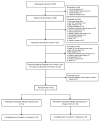Effects of Advice to Drink 8 Cups of Water per Day in Adolescents With Overweight or Obesity: A Randomized Clinical Trial
- PMID: 28264082
- PMCID: PMC5530362
- DOI: 10.1001/jamapediatrics.2017.0012
Effects of Advice to Drink 8 Cups of Water per Day in Adolescents With Overweight or Obesity: A Randomized Clinical Trial
Abstract
Importance: Health care professionals commonly recommend increased water consumption, typically to 8 cups per day, as part of a weight-reducing diet. However, this recommendation is based on limited evidence and virtually no experimental data from the pediatric population.
Objective: To compare 2 standardized weight-loss diets among adolescents with overweight or obesity, either with or without additional advice and behavioral support to increase habitual water intake to 8 cups per day.
Design, setting, and participants: A randomized clinical, parallel-group trial was conducted between February 2, 2011, and June 26, 2014, at Boston Children's Hospital, Boston, Massachusetts, among 38 adolescents with overweight or obesity who reported drinking 4 cups or less of water per day.
Interventions: All participants in both groups received similar weight-reducing interventions, differentiated by advice about water intake (the water group received advice to increase water intake to 8 cups per day; the control group did not receive such advice) but controlled for other dietary recommendations and treatment intensity. The interventions included dietary counseling, daily text messages, and a cookbook with health guides. To support adherence to 8 cups of water per day, the water group received well-defined messages about water through counseling and daily text messages, a water bottle, and a water pitcher with filters.
Main outcomes and measures: The primary outcome was 6-month change in body mass index z score. Data analyses followed the intention-to-treat principle.
Results: All 38 participants (27 girls and 11 boys; mean [SD] age, 14.9 [1.7] years) completed the study. Both groups reported drinking approximately 2 cups of water per day at baseline. Self-reported change in water intake at 6 months was greater in the water group (difference from baseline, 2.8 cups per day [95% CI, 1.8 to 3.8]; P < .001) compared with that in the control group (difference from baseline, 1.2 cups per day [95% CI, 0.2 to 2.2]; P = .02) (difference between groups, 1.6 cups per day [95% CI, 0.2 to 3.0 cups per day]; P = .03). The 6-month change in body mass index z score did not differ between the water group (difference from baseline, -0.1 [95% CI, -0.2 to -0.0]; P = .005) and the control group (difference from baseline, -0.1 [95% CI, -0.2 to -0.0]; P = .008) (difference between groups, -0.0 [95% CI, -0.1 to 0.1]; P = .88).
Conclusions and relevance: Advice and behavioral supports to consume 8 cups of water per day in the context of a weight-reducing diet did not affect body weight among adolescents with overweight or obesity. Despite intensive behavior supports, few adolescents achieved the target of 8 cups of water per day. Environmental interventions to reduce barriers to water consumption at school may be necessary in future research of the feasibility and effectiveness to achieve the target of an intake of 8 cups of water per day in adolescents.
Trial registration: clinicaltrials.gov Identifier: NCT01044134.
Conflict of interest statement
Dr. Ludwig received royalties for books on obesity and nutrition. Other authors declare no conflicts of interest relevant to this manuscript.
Figures
References
-
- Valtin H. “Drink at least eight glasses of water a day.” Really? Is there scientific evidence for “8 × 8”? Am J Physiol Regul Integr Comp Physiol. 2002 Nov;283(5):R993–1004. - PubMed
-
- Panel on Dietary Reference Intakes for Electrolytes and Water, Standing Committee on the Scientific Evaluation of Dietary Reference Intakes, Food and Nutrition Board, Institute of Medicine. Dietary Reference Intakes for Water, Potassium, Sodium, Chloride, and Sulfate. Washington, DC: National Academy Press; 2004.
Publication types
MeSH terms
Substances
Associated data
Grants and funding
LinkOut - more resources
Full Text Sources
Other Literature Sources
Medical


